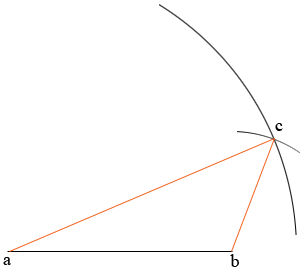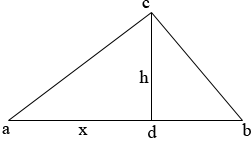| |||
| Math Central | Quandaries & Queries |
|
Question from Becc, a student: I have to find the height of a triangle. I DON'T KNOW ANY OF THE ANGLES so I can't draw the triangle and measure. Is there any such formula to find the height? |
Hi Becc,
You can draw the triangle if you wish.
Draw a line segment of length 3.1 cm and label the endpoints a and b. Set the point of a compass at a and with a radius of 4 cm draw an arc of a circle.

Move the compass point to b and draw an arc of radius 2 cm draw another arc. Call the intersection of the arcs c. Complete the triangle abc.

You can now measure the height.
The value you obtain for h depends on the accuracy with which you can measure, both the measurement of h and the measurements in the construction. A better way to find the height is to use algebra.
Draw a triangle and label it abc. Draw a line from c, perpendicular to ab to meet ab at d. |CD| = is the height of the triangle. Let |ad| = x.

(In the construction I found that the triangle is obtuse but that's not how I drew the triangle above. The calculations will show that abc is obtuse.)
Triangles adc and dbc are right triangles so using Pythagoras theorem
|ac|2 = h2 + x2
and
|bc|2 = h2 + |db|2
Substituting your numbers
42 = h2 + x2
and
22 = h2 + (3.1 - x)2
Solve these equations for x and then substitute the value for x into 42 = h2 + x2 to find h. When you do this you will see that x is larger than |ab| = 3.1 cm so d is to the right of b and the triangle is obtuse.
Penny
 |
||
Math Central is supported by the University of Regina and The Pacific Institute for the Mathematical Sciences.